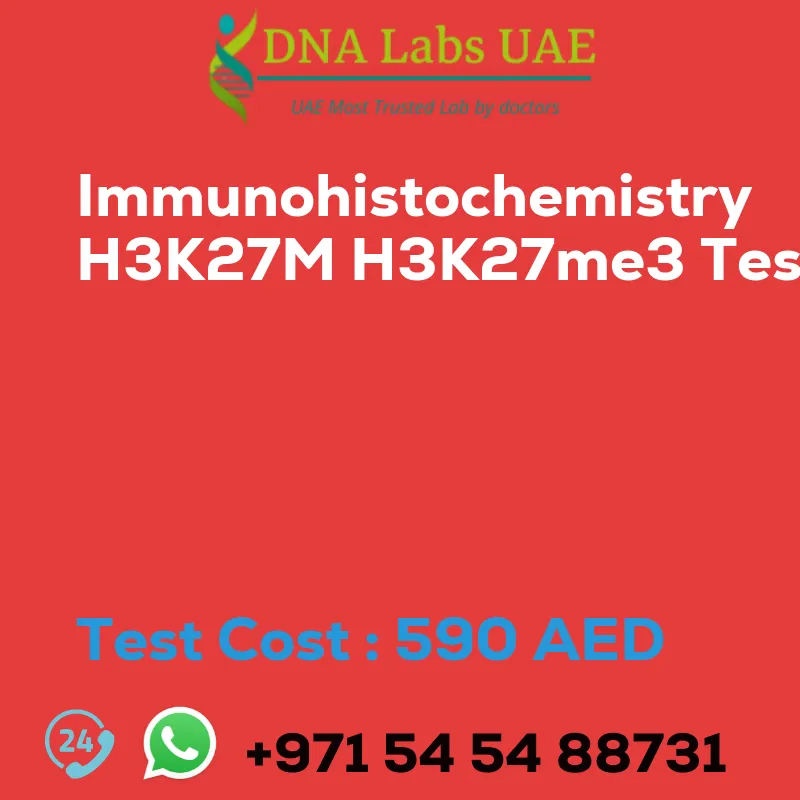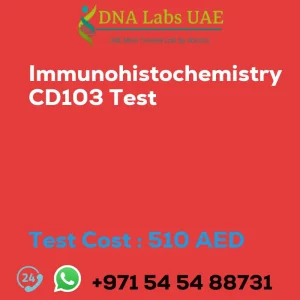IMMUNOHISTOCHEMISTRY H3K27M H3K27me3 Test
Test Name: IMMUNOHISTOCHEMISTRY H3K27M H3K27me3 Test
Components: Immunohistochemistry
Price: 590.0 AED
Sample Condition: Submit tumor tissue in 10% Formal-saline OR Formalin fixed paraffin embedded block. Ship at room temperature. Provide a copy of the Histopathology report, Site of biopsy and Clinical history.
Report Delivery: Sample Daily by 6 pm; Report Block: 5 days Tissue Biopsy: 5 days Tissue large complex: 7 days
Method: Immunohistochemistry
Test Type: Cancer
Doctor: Oncologist
Test Department: HISTOLOGY
Pre Test Information: Provide a copy of the Histopathology report, Site of biopsy and Clinical history.
Test Details
The H3K27M / H3K27me3 test is an immunohistochemistry (IHC) test used to detect the presence of mutations in the H3K27M gene and the levels of H3K27me3 protein in tissue samples. H3K27M is a mutation found in certain pediatric brain tumors, particularly diffuse intrinsic pontine gliomas (DIPGs) and midline gliomas. This mutation leads to the substitution of a methionine (M) residue for a lysine (K) residue at position 27 of the histone H3 protein. H3K27me3 is a histone modification that plays a role in gene regulation and is typically associated with gene silencing.
The presence of H3K27me3 in tissue samples can provide information about the epigenetic state of the cells. The H3K27M / H3K27me3 test involves staining tissue sections with specific antibodies that target H3K27M and H3K27me3. The antibodies bind to their respective targets, allowing for their detection and visualization under a microscope. The staining pattern and intensity can provide information about the presence and distribution of the H3K27M mutation and the levels of H3K27me3 in the tissue.
This test is primarily used in research and clinical settings to aid in the diagnosis and classification of brain tumors, particularly DIPGs and midline gliomas. It can help differentiate between different types of brain tumors and provide valuable information for treatment planning and prognosis. It is important to note that the H3K27M / H3K27me3 test is not a standalone diagnostic test and is typically used in conjunction with other diagnostic methods, such as imaging studies and genetic testing, to provide a comprehensive evaluation of brain tumors.
| Test Name | IMMUNOHISTOCHEMISTRY H3K27M H3K27me3 Test |
|---|---|
| Components | |
| Price | 590.0 AED |
| Sample Condition | Submit tumor tissue in 10% Formal-saline OR Formalin fixed paraffin embedded block. Ship at room temperature. Provide a copy of the Histopathology report, Site of biopsy and Clinical history. |
| Report Delivery | Sample Daily by 6 pm; Report Block: 5 days Tissue Biopsy: 5 days Tissue large complex : 7 days |
| Method | Immunohistochemistry |
| Test type | Cancer |
| Doctor | Oncologist |
| Test Department: | HISTOLOGY |
| Pre Test Information | Provide a copy of the Histopathology report, Site of biopsy and Clinical history. |
| Test Details |
The H3K27M / H3K27me3 test is an immunohistochemistry (IHC) test used to detect the presence of mutations in the H3K27M gene and the levels of H3K27me3 protein in tissue samples. H3K27M is a mutation found in certain pediatric brain tumors, particularly diffuse intrinsic pontine gliomas (DIPGs) and midline gliomas. This mutation leads to the substitution of a methionine (M) residue for a lysine (K) residue at position 27 of the histone H3 protein. H3K27me3 is a histone modification that plays a role in gene regulation and is typically associated with gene silencing. The presence of H3K27me3 in tissue samples can provide information about the epigenetic state of the cells. The H3K27M / H3K27me3 test involves staining tissue sections with specific antibodies that target H3K27M and H3K27me3. The antibodies bind to their respective targets, allowing for their detection and visualization under a microscope. The staining pattern and intensity can provide information about the presence and distribution of the H3K27M mutation and the levels of H3K27me3 in the tissue. This test is primarily used in research and clinical settings to aid in the diagnosis and classification of brain tumors, particularly DIPGs and midline gliomas. It can help differentiate between different types of brain tumors and provide valuable information for treatment planning and prognosis. It is important to note that the H3K27M / H3K27me3 test is not a standalone diagnostic test and is typically used in conjunction with other diagnostic methods, such as imaging studies and genetic testing, to provide a comprehensive evaluation of brain tumors. |








